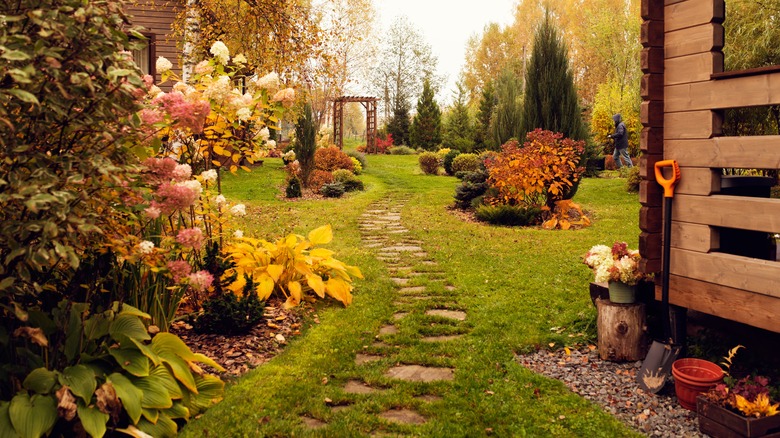The Drought-Tolerant Ground Cover That Turns A Lovely Pink In The Fall
When you think of a thriving garden, vibrant flowers, tall grass, and sculpted shrubs might come to mind. But it's time ground covers got a seat at the popular table. These low-growing plants are perfect to add color and texture to your yard. They can be a beautiful plants that'll also help prevent pesky weeds, stop soil erosion, and boost curb appeal. White stonecrop (Sedum album) is a great ground cover option for those who want to cash in on all those benefits with a gorgeous drought-tolerant plant. It's easy to grow, and its green succulent leaves turn a pinkish copper color in the fall that will give your outdoor space a distinct look.
If you've killed far too many plants from underwatering or live in an area with little rainfall, then you might have better luck with white stonecrop. Succulent leaves absorb and retain water, making the ground cover drought-tolerant and heat-resistant once it's established. As this succulent plant survives through the lack of water and intense heat, you'll be rewarded with vibrant star-like white flowers in the summer that can lure songbirds, butterflies, and other pollinators. After the flowers fade in August, a new color emerges as the green foliage turns pinkish-brown from autumn to winter.
Planting and caring for white stonecrop
White stonecrop is a low-maintenance plant that will flourish in USDA hardiness zones 3 to 9. With the right conditions, it grows up to 4 inches tall and spreads up to 18 inches wide. Dry to moist, well-drained soil and full sun to partial shade is best for the white stonecrop ground cover to thrive. Neutral and alkaline clay, sandy, or rocky soil is preferred, and you don't have to worry about fertilizer or compost — white stonecrop is tolerant of poor soil. The soil should dry completely between waterings, so rainfall every 2-3 weeks should be enough to meet the ground cover's needs. And if there's a drought, white stonecrop won't mind. It can still flourish with low to no water. Further, periods of dryness cause the leaves to deepen in their red hue or even vary to a rich brown, while increased moisture keeps the plump leaves green.
Although white stonecrop isn't one of the fast-spreading invasive ground covers to avoid, it is an aggressive grower. That can be a good thing if you want to quickly blanket your yard with evergreen foliage. However, since white stonecrop can only tolerate light foot traffic (the leaves fall off if trampled), it's not a suitable alternative to lawn grass, and you don't want to plant it in a walkway or where pets play. White stonecrop is best for mass planting, garden borders, and containers. With its white blossoms in the summer and evergreen leaves that turn a rosy hue during the colder seasons, it's the perfect ground cover for year-round color in your garden.

